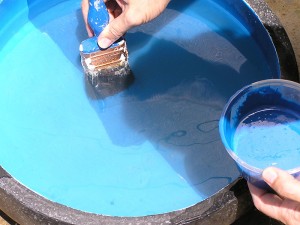Occasionally epoxy paint may get damaged, suffer from hydrostatic pressure, returning osmosis (in fibreglass pools) or some other localised damage, such as dislodgement of the substrate (Render, Marblesheen) Though epoxy is tough, mechanical impact or pressure may have been sufficient to dislodge an area. Generally, this may be repaired without emptying the pool if the affected areas are less than about 300 x 300 mm each (1 sq ft).
Firstly, carry out an assessment to determine the cause of the issues. If these are the result of mechanical damage, then it will be quite evident. If the cause is water pressure from behind, (hydrostatic) then it can be painted over, but may come back unless the cause has been addressed. The same applies to osmosis issues.
Once you have determined the extent of work to be undertaken, obtain sufficient amount to carry out the repairs. One standard pack covers about 25 -30 sq M in one coat, or maybe a “touch up” pack covering about 1.5 – 2 sq m in one coat. Don’t forget to get the right colour, though it will not match the original exactly due to wear and tear on the original coating. However, over time the repaired area can be expected to meld into the older epoxy.
Having got your epoxy paint and all other equipment etc (refer to Surface Preparation and Application Notes), then it’s time to undertake the work.
How accessible are the areas to be worked on? Can you carry out necessary surface preparation and application without dropping the water for easier access? (To repair holes underwater use Selley’s Knead – it, Aqua grade, from Bunnings)
When completely ready, mix up two packs of epoxy paint. You may want a touch up kit or a small pack size. Or carefully weigh out the Resin and Hardener in the ratio of 4 parts to 1 part, by weight.
Thoroughly wet out and load up either a suitable size brush or roller so as to cover the area in ONE application. As a guide 20 – 50 mm wide, “thick” brush for areas from 30 – 200 mm wide areas and a 150 mm roller (20 mm nap) for areas 200mm – 300 wide.
If taking the loaded brush or roller below about 300 mm (1 ft) place in a plastic bag, close top, carry very close to area to be painted, open bag allowing water to flow in and slowly remove from bag. If recoating close to the surface, no bag is necessary. Place in the middle of the area to be painted and slowly spread paint around, without disturbing water any more than necessary. Carefully finish off in one direction, and then replace in bag and bring to surface. It may be possible to reload brush/roller for a couple of applications, before replacement is necessary. (Water mixed with epoxy paint in this fashion is generally not an issue).
The idea is to get epoxy paint on in one coat as a replacement situation. It should not be necessary to apply 2 coats. If wanted, allow 1st coat to cure for a few days, sand it lightly (#80 -100) and apply second coat.
Upon completion there may be a slight paint residue on pool water surface; this should disappear within a day or so of running the filter. The new paint should be fully hard within 5 – 7 days so treat with care till then, after which time the pool can be used.
Contact us for more specific advice.
 |
 |
